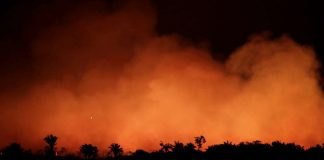AUGUST 28, 2019
 As the ice melts at an alarming rate, the people of Greenland are experiencing first hand what the new climate reality will be
As the ice melts at an alarming rate, the people of Greenland are experiencing first hand what the new climate reality will be
A heatwave is gripping The Arctic, melting away Greenland’s ice sheet on an unprecedented scale and threatening a global rise in sea levels – an urgent reminder of the climate crisis we are now all facing.
Kids splashing each other in the sea and locals wearing T-shirts were unheard of here in August 10 years ago.
But now, alongside teenage girls wearing skirts to school and increasing mosquitoes, it is a common occurrence for the residents of Qaanaaq, in north-west Greenland, one of the world’s most northerly cities situated 700 miles north of the Arctic Circle.
Greenland, the world’s largest island at almost three times the size of France, is now living with extreme environmental changes which could see the Arctic Sea free of ice by 2030 if no action is taken.
 Teenagers in Qaanaaq play football on the beach during the never-seen-before heatwave. – Adam Gerrard/Daily Mirror
Teenagers in Qaanaaq play football on the beach during the never-seen-before heatwave. – Adam Gerrard/Daily Mirror
I travelled to Greenland, home to just 56,000 people, last week to see first hand the drastic changes to conditions and to understand why it matters to us all.
Away from headlines about melting ice caps and pictures of underfed polar bears unable to stalk seals on flimsy ice forced to invade towns for food, I found a community battling to adjust.
 The Mirror’s Environment Editor Nada Farhoud pictured in a t-shirt in late evening sunshine on the beach in Qaanaaq during the recent heatwave. – Adam Gerrard/Daily Mirror
The Mirror’s Environment Editor Nada Farhoud pictured in a t-shirt in late evening sunshine on the beach in Qaanaaq during the recent heatwave. – Adam Gerrard/Daily Mirror
Living alongside a backdrop of eerily beautiful icebergs and utterly terrifying melting sea ice and retreating glaciers is having a devastating impact on species, habitats and human life.
This is the frontline of climate change.
 Back in 1971, this is how Qaanaaq residents dressed and got around in early summer. Orfik Duneq, his wife Judithe and daughter Jacobine are on an ice floe raft. – arcticphoto.com
Back in 1971, this is how Qaanaaq residents dressed and got around in early summer. Orfik Duneq, his wife Judithe and daughter Jacobine are on an ice floe raft. – arcticphoto.com
Three-quarters say they have personally experienced the impact of global warming in their daily lives, from coping with dangerous sea ice journeys to having hunting sled dogs put down for economic reasons due to shorter winters – with many unaware of the full impact.
While we may shrug at the decline of traditional hunting, it is impossible to visit Greenland and not be profoundly affected by their tales of how climate change has upturned their world in just a single generation.
Families have been torn apart, livelihoods threatened giving us all an insight into the scale of the battle now facing humanity.
 Our team witnesses icebergs falling into the ocean in these incredible scenes shot at a sea terminating glacier close to Siorapaluk, Greenland
Our team witnesses icebergs falling into the ocean in these incredible scenes shot at a sea terminating glacier close to Siorapaluk, Greenland
“If all of Greenland’s ice were to melt, it would raise global sea levels by 21fett meaning cities like London, Sydney and New York underwater and the whole of Bangladesh would disappear,” says Mark Wright, director of science at WWF, who accompanied the Daily Mirror to the Arctic.
“This is not science fiction. This is the reality of climate change.
 Siorapaluk elder Joseph Manumina is adjusting to rapid climate change, and has already been forced to change livelihoods. – Adam Gerrard/Daily Mirror
Siorapaluk elder Joseph Manumina is adjusting to rapid climate change, and has already been forced to change livelihoods. – Adam Gerrard/Daily Mirror
“It is happening now – and here in accelerated terms – providing a crucial insight into what we will all face unless urgently tackle this now.
Sea ice now forms here two months later and melts one month earlier – as temperatures rise twice as fast as the global average.
This summer has seen more than 100 wildfires in the Arctic Circle devastating once pristine forests, turning them from precious carbon dioxide absorbing sponges into giant new emitters of greenhouse gases.
The country is also experiencing record-breaking temperatures. In mid-June, along the eastern coast it was 9C warmer than the 1981-2010 average.
 In Greenland, sea ice now forms two months later and melts one month earlier – as temperatures rise twice as fast as the global average.
In Greenland, sea ice now forms two months later and melts one month earlier – as temperatures rise twice as fast as the global average.
Just as western Europe has baked in a heatwave with record temperatures at the end of July, the hot air moved as far north as Greenland with the gauge hitting 22C on August 1. The average high is around 7C.
Journeys around the coast which took three weeks in the 1970s because of the sea ice now take a single day.
Perched beneath the world’s second largest ice cap after Antarctica, nothing other than black moss and lichen grow here.
 A spectacular iceberg floats off, as it melts near the northernmost outpost of Greenland, Qaanaaq
A spectacular iceberg floats off, as it melts near the northernmost outpost of Greenland, Qaanaaq
Fourth fifths of Greenland is buried under an ice sheet two miles thick, much of it three million years old.
But in the blink of an eye in geological terms it has begun melting – and much faster than climate change models predicted.
Around 60% is affected, including higher elevations that only rarely see temperatures climb above freezing.
In July alone 200 billion tonnes of meltwater poured into the Atlantic – enough to raise sea levels by 0.5mm.
We take a small fishing boat out with Joseph Manumina, 75, who points to a glacier he used to cross in a five-metre sled pulled by 16 huskies in the winter.
 Qaanaaq
Qaanaaq
But like thousands of others here, the fourth-generation hunter has been forced to abandon his family trade and is now a fisherman.
Joseph stops his boat beside the Hiawatha glacier and points out when he was young it stretched hundreds of metres further into the fjord.
“The land you can now see was not visible at all a few years ago. But heavy rains came in 2016 and changed the landscape for good,” he said.
Last year, thanks to significant melting, scientists discovered a 19-mile-long crater – the first to be found under ice – believed to be a direct result of a meteorite impact.
While similar melting effects are being measured in the southern hemisphere, the Greenland sheet may be uniquely vulnerable, lying much further from the chill of the pole than Antarctica’s.
Scattered across 17 small towns and approximately 60 villages, all situated on a narrow coastal strip, Greenland’s residents have often been overlooked by data science.
But a first-ever national survey has examined the human impact of the climate emergency – showing 90% of islanders interviewed fully accept that the climate crisis is happening.
The Greenlandic Perspectives Survey was carried out by the University of Copenhagen’s Center for Social Data Science, the Kraks Fond Institute for Urban Economic Research and the University of Greenland.
 Humpback whales swim close to icebergs in this photograph taken by drone close to the city of Ilulissat, Greenland, as part of the Mirror investigation into the climate crisis. – Adam Gerrard/Daily Mirror shot with DJI Mavic 2 Pro
Humpback whales swim close to icebergs in this photograph taken by drone close to the city of Ilulissat, Greenland, as part of the Mirror investigation into the climate crisis. – Adam Gerrard/Daily Mirror shot with DJI Mavic 2 Pro
Lead author Kelton Minor said: “The Arctic is a bellwether for the unequal impact of global warming on social and economic systems.
“As countries struggle to limit future risks and overall warming to 1.5C many Arctic and Greenlandic residents are already living in regional climates that have changed by more than this, in less than a lifetime.
“Therein lies the paradox: while satellites and sensors monitor the surface of Greenland’s ice sheet, chase icebergs and scan sea ice daily, relatively little is known about what the residents of Greenland think about their changing surroundings.”
July 31st was the biggest melt day since at least 2012, when 97% of sheet experienced melt.
Studies found ice melt periods like the one seen seven years ago typically occur about every 250 years. One occuring so quickly is an important sign how quickly the climate is changing, warn experts.
“This is a double edged sword, says Mark Wright, director of Science at WWF.
“What we do here in the UK, they way we live our lives by burning fossil fuels, is speeding up the change.
“At the same time this is affecting Greenland and other Arctic countries. But what happens here will also affect what happens at home in terms of our weather patterns and security in coastal areas.
“This is why we have to take action and now.
“We don’t have long left to cap this rapid change that we’ve never seen before in human history.”
The rapid melting is also opening up new shipping routes and mining opportunities for deposits of rare-earth elements used in technology previously buried under ice sheets hundreds of metres thick.
 Calved icebergs – those that have broken away due to melting – at a sea terminating glacier close to Siorapaluk. – Adam Gerrard/Daily Mirror
Calved icebergs – those that have broken away due to melting – at a sea terminating glacier close to Siorapaluk. – Adam Gerrard/Daily Mirror
It has sparked the interest of American President Donald Trump with an attempt to buy it, while China already has a mine on the island.
While it is impossible to put a price on the territory, estimates range from $1.1 trillion to $1.7trillion depending on the mining potential – believed to be enough to meet 25% of the world’s demand in the next 50 years.
Trump may have cancelled his trip to Denmark for now but his suggestion is a marker of the fact Greenland is also now at the heart of a new battle for supremacy in the Arctic, where superpower competition is heating up as fast as the ice is melting.
What is happening and why it matters…
- If global temperatures rise by 2C, virtually sea-ice free summers could happen in the Arctic every 10 years.
- Rapid and deep cuts to global carbon emissions to prevent the global average temperature from rising above 1.5C is needed to stabilise the worst impact of climate change.
- Four ancient viruses have been uncovered by previously frozen soil since 2004.
- Over 60% of Greenland’s ice sheet is experiencing melting.
- 31st July was the biggest melt day since 2012 with about more than 10 billion tones of ice lost to the ocean from surface melt.
- In July, 197 billion tonnes of melted ice sheet poured into the Atlantic Ocean – enough to raise sea levels by 0.5mm.
- The thick-billed Murre bird is at real risk of extinction in Greenland due to climate change. The little auk is also in decline due to warming and is crucial to the local ecosystem as it fertilises the land with nutrients from the sea.
Courtesy/Source: Mirror










































































































